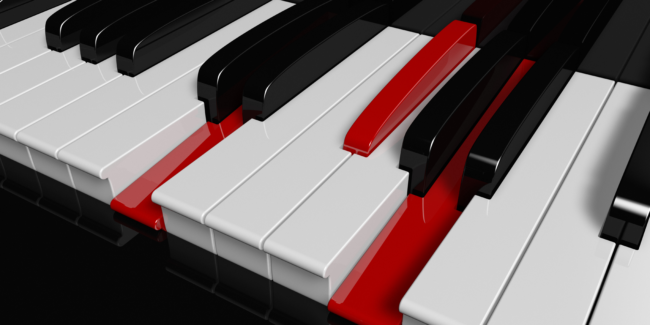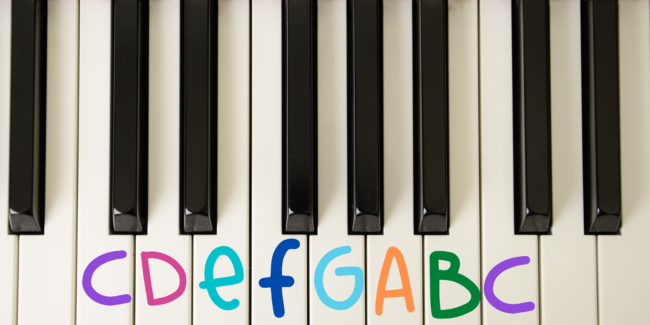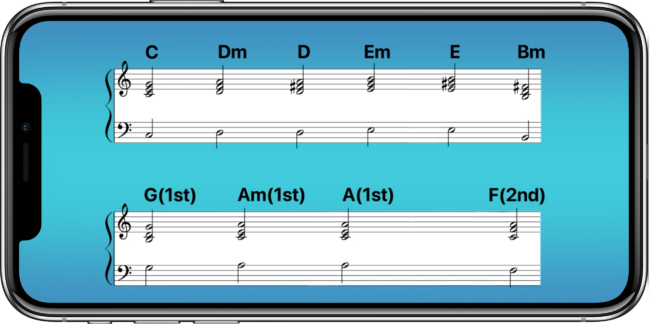Piano Chords for Beginners: A Simple Guide

Do you want to learn piano chords? Here’s a quick guide that will help you master the basics.
Playing piano chords can be overwhelming. You sit there and can’t quite make sense of all the different keys sprawling out before you in a pattern of black and white.
Should you press one key at a time? Or maybe three? Do you use all ten fingers? And how do you figure out what it is that you’re hearing when the sound comes out?
We will answer all of these questions for you and more in this short guide by explaining the basic building blocks of notes, scales, and chords.
What’s a note?
Each key on the piano operates in the same way. When you press down, a small hammer hits a string (keyboards mimic this effect). Each string tightens so that it produces a sound at a particular frequency when the hammer strikes. This frequency is called pitch. The tighter the string, the higher the pitch.

Western musical instruments have twelve frequencies, each one separate by the same amount of space or distance. These frequencies are called notes. On the piano, sets of twelve keys represent these twelve notes that repeat themselves across lower and higher pitch registers.
For example, if you go to the fourth key from the bottom of the piano and play it simultaneously with the highest key on the piano, you will see the same note (both C) at different pitches.
The musical element created by notes is melody. When we hear the melody of a song, we essentially hear a series or pattern of notes, one after the other in time, in whichever register of pitch is accessible to the instrument.
What’s a scale?
A scale combines seven notes, played one after the other, and carries a unique character or flavor. But what creates this flavor is the spaces between the notes. These spaces are called intervals.
If you play all twelve notes in a row – a chromatic scale – you would hear the same interval between each note. This small interval is known as a semitone.
Smaller frequencies exist, but Western music doesn’t have notes or names for them. Similar to how we have whole numbers and lots of decimals between them.
For whatever reason, we have twelve notes but use only seven letters to name them:
A, B, C, D, E, F, G
For this reason, we have the symbols of sharp ‘#‘, to raise by a semitone, and flat ‘b‘, to lower by a semitone. This is how all the keys on the piano receive their names, with the black keys traditionally being the sharps and flats.
Many notes have two names, depending on the context of the scale. For example, you can also call C# a Db because it sits between C and D.
The major scale.
The major scale is the most common scale and is best for beginners. This unique combination of notes has given birth to almost all popular Western music for hundreds of years!

The intervals which make up the major scale are semitones and tones ( two semitones), in the following famous pattern:
T, T, ST, T, T, T, ST
The piano is arguably the best instrument for learning scales because you have all of the notes clearly mapped out, and you can practice across all the registers of pitch.
The best place to start is with the C major scale. What does this mean? You apply the above pattern to the keys, starting on note C, and you will see that your major scale is made up of only the white keys – making it easy to visualize and execute. For example,
C T D T E ST F T G T A T B ST C
What’s a piano chord?
Chords are a combination of two or more notes (from any scale) that you can play simultaneously. Most piano chords comprise of three notes or a triad. You can achieve a wide range of variations by adding a fourth or fifth note.

Every chord has a unique sort of identity or mood. The chords you choose to play will determine if the song is joyous and celebratory, melancholy and reflective, or angry and frightening.
When you place chords in a progression, they become the song’s fabric upon which you can play the melody.
To explain how we build piano chords, let’s label the notes in a C major scale from one to seven:
CD E F G A B
1 2 3 4 5 6 7
To build piano chords from this scale, we have to make different combinations of notes. You can build most chords with the following pattern:
1,3,5 (C major)
More complex chords require one or two more notes in the same pattern:
1,3,5,7 (C major 7)
Major chords.
The major chord is like the home base of most music and the best starting point for beginners. People often describe it as the ‘happy’ chord family because its sound is bright and resonant. So how do you play one?
First have to choose the root note, or the 1. For example, in F major, the root note is F. To figure out which other notes belong in this chord, go to the F major scale and find the 1,3, and 5 (F, A, and C).
1 3 5
F A C
M3 m3
Minor chords.
The minor chord has a darker, more solemn mood. You can use it to create drama, suspense, or pathos. Want to learn how to make one?
Minor chords take the pattern of 1,3,5 and make the ‘3‘ lower (flattening it) by one semitone. This creates the pattern 1, b3, 5, which also changes the interval relationships in the chord.
For example:
1 b3 5
F Ab C
m3 M3
In the same way that the major scale is a pattern of intervals (T, T, ST, T, T, T, ST), the major chords are patterns of two intervals: major third (M3), containing four semitones, and a minor third (m3) containing two semitones.
What’s a piano chord progression?
To understand chord progression, we have to understand the way chords work within scales.
Progressions in popular music often have chords that combine notes from the same scale – the song’s key. If the chords stick strictly to their key, the melody is diatonic.
When songs switch between different keys, it is called modulation.
If we were to build chords using the 1,3,5 pattern, starting on each number of the scale, and only using the notes within the scale, it would look something like this:
| 1 | 2 | 3 | 4 | 5 | 6 | 7 |
| C | D | E | F | G | A | B |
| E | F | G | A | B | C | D |
| G | A | B | C | D | E | F |
We then examine the intervals within each chord based on their root to determine whether they are major (1,3,5) or minor (1,b3,5). Then we end up with a pattern like this:
| 1 | 2 | 3 | 4 | 5 | 6 | 7 |
| C major | D minor | E minor | F major | G major | A minor | B diminished (1,b3,b5) |
This pattern becomes the foundation of most chord progressions in popular Western music, enabling a quick and clear shorthand language for communicating with other musicians. The 1-4-5 progression, for example, is perhaps the most well-known. In the key of C major, this would be C major, F major, and then G major.
This is a lot of information, but we’re confident this guide will help you play chords in no time!
Do you have a song you can’t wait to play? Share with us in the comments below!









